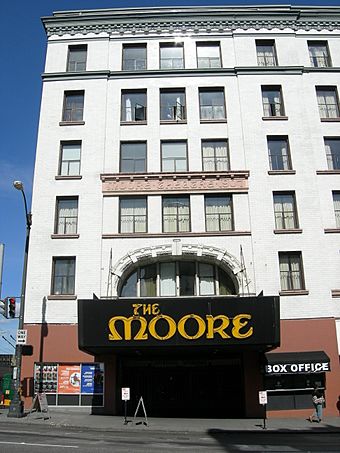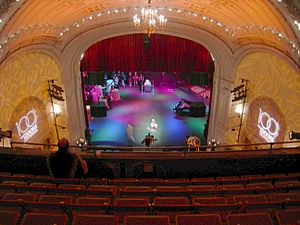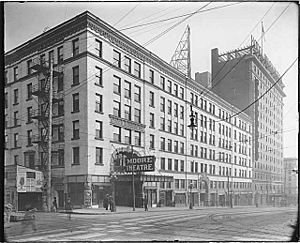Moore Theatre facts for kids

Entrance to the Moore Theatre in 2007
|
|
| Address | 1932 2nd Ave Seattle, Washington, U.S. |
|---|---|
| Owner | Seattle Theatre Group |
| Capacity | 1,800 |
| Current use | Performing arts venue |
| Construction | |
| Opened | December 28, 1907 |
| Architect | E. W. Houghton |
| Website | |
| www.stgpresents.org | |
|
Moore Theatre and Hotel
|
|
| NRHP reference No. | 74001958 |
| Significant dates | |
| Added to NRHP | August 30, 1974 |
The Moore Theatre is a historic performing arts center in Seattle, Washington, United States. It has 1,800 seats and is located near Pike Place Market. The theater opened in 1907 and is Seattle's oldest active theater. It hosts many different shows, including plays, concerts, and talks. The Seattle Theatre Group manages the Moore Theatre. This group also runs the larger Paramount Theatre and the Neptune Theatre.
Contents
Discovering the Moore Theatre's Past
How the Moore Theatre Began
The Moore Theatre was built for James A. Moore, a real estate developer in Seattle. E. W. Houghton designed the building. It was meant to be a fancy place for important people in Seattle to gather in the early 1900s. The theater opened in late 1907. This was just before the Alaska–Yukon–Pacific Exposition, a big fair that was planned for Seattle. The Moore Theatre and the hotel next to it were built to welcome and entertain visitors for this event.
Changes Over the Years
At first, John Cort ran the theater. He later started a famous theater on Broadway in New York. The Moore Theatre continued to host shows through the 1930s. However, as entertainment changed, the theater faced challenges by the 1970s.
In 1975, Dan Ireland and Darryl MacDonald took over the theater's lease. They renamed it the Moore Egyptian. They added "Egyptian" to the name to make it sound more exciting. There had been another Egyptian Theater in Seattle before this.
The Moore Egyptian and Film Festival
Ireland and MacDonald turned the theater into a place for movies. The Seattle International Film Festival started at the Moore Egyptian in 1976. In 1981, the theater's owners decided not to renew their lease. They moved to a different building and took the "Egyptian" name with them.
A Historic Landmark
The Moore Theatre and Hotel were added to the National Register of Historic Places in 1974. Since the 1980s, the theater has been a popular spot for touring musicians and plays. Today, it can seat about 1,800 people.
The Moore Theatre also shows a part of history when people were separated by race in the United States. There was a "colored entrance" for Black audience members. This entrance led to the balcony, which was a separate seating area. This entrance can still be seen around the corner from the main entrance.
Exploring the Moore Theatre's Design
Building Materials and Style
The Moore Theatre is made of strong concrete. It has a huge steel beam that holds up the balcony without needing extra support poles. The outside of the theater is covered with white ceramic tiles. Its design mixes styles from Byzantine and Italian buildings. The outside looks simpler compared to the very fancy inside.
Inside the Theater
The stage area was the biggest in Seattle when it was built. It had a very modern electrical system for its time. There were also many dressing rooms for performers. When it first opened, the Moore Theatre could seat 2,436 people. This made it one of the largest theaters in the U.S. at that time. The Moore was known for its new design, expensive materials, and beautiful decorations.
Separate Seating Areas
The upper balcony, though nice for its time, was originally set apart from the rest of the theater. This was due to racial segregation. It once had its own separate entrances. Even today, it has a separate staircase that connects it to just inside the front door.
The Architect's Other Work
E. W. Houghton, the architect for the Moore, also designed the Seeley Theatre in Pomeroy, Washington. Like the Moore, the Seeley Theatre uses a steel beam to support its balcony without extra columns. The Seeley Theatre currently seats 270 people.
Famous Performances at the Moore Theatre
Many famous artists and shows have been recorded at the Moore Theatre:
- The Who's rock opera Tommy was first performed as a full stage show here in 1971. Bette Midler was part of this production.
- Soundgarden's Fopp music recording was made at the Moore Theatre in 1988.
- Alice in Chains' Live Facelift video was filmed at the Moore Theatre in 1990.
- Pearl Jam's "Even Flow" music video uses footage from a concert at the Moore Theatre in 1992.
- Mad Season's Live at The Moore video was filmed at the Moore Theatre in 1995.
- Jeff Tweedy of Wilco used parts of his performance at the Moore Theater in his concert film Sunken Treasure: Live in the Pacific Northwest.
- Wanda Sykes filmed her comedy special Sick & Tired there.
- Two Progman Cometh music festivals took place here in 2002 and 2003. These led to three live music albums.
- Seattle metal band Queensrÿche filmed their home-DVDs Mindcrime at the Moore and Live Evolution at this venue.
- Patton Oswalt's Finest Hour comedy album was recorded at the Moore.
- Jo Koy's comedy special "Live from Seattle" was filmed at the Moore in 2017.
- Bill Burr’s comedy special “Drop Dead Years” was filmed at the Moore in 2024.




